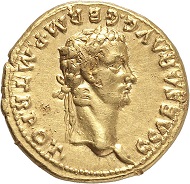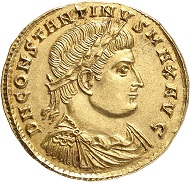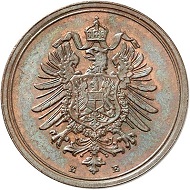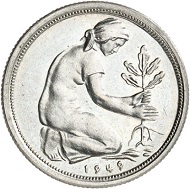13-03-2016 – 17-03-2016
Auctions 273-276
240,000 euros for an octuple ducat of the city of Gdansk
More than 3,000 bidders were competing for around 5,700 lots, which were called from four auction catalogs of the Künker spring-auction. And it was these bidders who provided the final auction result of 10.7 million euros when the original estimate was at 7.3 million euros. The coins of the Roman Empire played a significant part in this extremely impressive result, containing many perfectly preserved aurei. The strikings from this area alone fetched a final outcome of 2.2 million euros when the original estimate was at 1.4 million euros.
Auction 273: Antiquity
Of course there were many impressive results in the Greek section as well. For example, take a look at a decadrachme from Syracuse (75,000 / 80,000 euros) and an electron stater from Cyzicus featuring the Omphalos (7,500 / 12,000 euros), but let’s focus on the Roman Empire.
Lot 582: OCTAVIAN. Dupondius, 38 BC, Italian mint. With Divus Iulius Caesar. RPC 620. Very rare. Fine green patina. Extremely fine. Estimate: 5,000,- euros. Hammer price: 22,000,- euros.
Regardless of whether it was gold, silver or bronze, a great rarity or a common piece, if the coin was attractive, meaning its grade, striking, style and patina were right, it had a great chance of achieving a high price. Let’s take a closer look at three examples: A very rare dupondius of 38 B.C. was estimated at 5,000 euros. On its obverse it showed the portrait of Octavian and on its reverse the portrait of his deified adoptive father Caesar. The fine green patina and an exceptional style in regards to this particular emission, prompted collectors to boost its final bid to 22,000 euros. This lets the final bid of 1,700 euros for a Caligula quadrans, showing a pileus on its obverse, sound rather modest. But remember, normally these pieces fetch about 200 euros when in an attractive quality. With an original estimate at 200 euros, the final bid makes one realize that this quadrans certainly wasn’t just attractive: it was perfect! Additionally, it also derived from a Leu auction.
Lot 639: CALIGULA, 37-41. With Divus Augustus. Aureus, 37, Lugdunum. Very rare. Nearly extremely fine. Estimate: 60,000,- euros. Hammer price: 95,000,- euros.
Not all perfect, but extremely rare, were two aurei of the same type. On their obverses they showed Caligula and their reverses the deified Augustus. Originally estimated at 60,000 and 15,000 euros, they pretty much aligned during bidding in regards to pricing and sold for 95,000 resp. 75,000 euros.
Aurei in general, when in outstanding quality, have been achieving record prices for years now. Let’s look at some more sold at this auction: Vespasian (7,500 / 40,000 euros), Commodus (25,000 / 34,000 euros), Pertinax (15,000 / 36,000 euros), and Caracalla (50,000 / 60,000 euros).
Lot 669: ARISTOBULOS of Armenia Minor. AE, year 8 (= 61/62). RPC 3839. Very rare. Nearly very fine. Estimate: 750,- euros. Hammer price: 24,000,- euros.
Expecting these results, others were a complete surprise, except perhaps for the specialized collector. A perfect example is an inconspicuous bronze, estimated at 750 euros. On its obverse it showed the portrait of Aristobulus of Armenia Minor. Not many have probably heard of him. In comparison, everybody knows of Herod the Great and his stepdaughter Salome – yes, the one with the veil dance and the head of John the Baptist. Aristobulus was Herod’s grandson and the husband of Salome, which let the price of the coin climb up to 24,000 euros!
Just as much, that is 24,000 euros, was the final result of an extremely rare, but only nearly very fine sestertius of Domitia, originally estimated at 3,500 euros.
But also an antoninianus of the 3rd century was good for a surprise – a striking of Trajan Decius in perfect condition, deriving from the 1976 Kastner auction and arguably unique. With an original estimate at 500 euros its final bid arrived at 3,800 euros.
Lot 938: CONSTANTINE I, 306-337. Gold medallion of 1 1/2 solidi, 324, Nicomedia. Unique. Extremely fine. Estimate: 10,000,- euros. Hammer price: 55,000,- euros.
Last but not least, let’s consider two late Roman pieces: a golden medallion of 1 ½ solidi of Constantine I went over the auction block for 55,000 euros (estimate: 10,000 euros) and a solidus of Priscus Attalus was sold for 65,000 euros (estimate: 50,000 euros).
Auction 274: Medieval and early modern coins and medals / Collection of coins balances and weights
Plenty of interesting pieces of pre-1871 Germany and two special collections opened auction 274. Both, a series of Muenster strikings and Saxon coins drove in most satisfactory results.
Lot 2107: MUENSTER. Ferdinand of Bavaria, 1612-1650. 1/2 taler 1633. Extremely rare. Very fine. Estimate: 20,000,- euros. Hammer price: 24,000,- euros.
The frontrunner of the Muenster collection was an extremely rare half taler of Ferdinand of Bavaria from 1633 (20,000 / 24,000 euros), but also a reichstaler of 1688, the year of the vacancy of the Apostolic See (3,000 / 7,000 euros) and a 1714 reichstaler of Franz Arnold of Wolff-Metternich (5,000 / 11,000) achieved high final bids. The favorites of collectors of Saxony were the butterfly strikings, which again and again are associated with the Countess of Cosel, even though there is no evidence of such. The 16 groschen piece climbed up to 30,000 euros (estimated at 10,000 euros), the 4 groschen piece up to 13,000 euros (estimate: 3,000 euros), and the gold off-metal strike of 11 ducats – and here we prepone a result of Auction 275 – arrived at a final bid of 65,000 euros (estimate: 25,000 euros).
Lot 2935: DENMARK. Svend Estridsen, 1047-1074. Denarius, Lund. Very rare. Nearly extremely fine. Estimate: 1,000,- euros. Hammer price: 6,500,- euros.
Collectors of Viking period coins of Great Britain, Ireland, Denmark and Norway most certainly were also waiting for the day of auction 274, when an extensive collection came under the hammer, which was characterized not only by the rarity of the pieces offered, but also their grade. Literally every lot achieved a multiple of its original estimate. Let us tell you about the frontrunners: There was a very rare, fully centered and struck Danish denarius of Svend Estridsen, minted in Lund. This almost extremely fine specimen, showing an eagle with spread wings on its reverse, was sold for 6,500 euros (estimate: 1,000 euros). 24,000 euros was the final bid for a penny of Alfred the Great, minted in London (estimate: 10,000 euros).
Lot 3167: IRELAND. Penny, Dublin. Phase I. Very rare. Extremely fine. Estimate: 2,500,- euros. Hammer price: 11,000,- euros.
A surprising 11,000 euros was realized by an anonymous Irish penny, minted in the name of Sithrics in Dublin around 1000 (estimate: 2,500 euros), and finally a Swedish pfennig of the 11th century from Sigtuna changed hands for 3,000 euros (750 euros).
Last but not least, a rare cincuentin from the Spanish mint of Segovia went over the auction block, for which the new holder was willing to pay 50,000 euros (estimate: 30,000 euros).
Lot 4386: POLAND. Danzig, city. 8 ducats 1644, with title of Vladislaus IV (1632-1648). Extremely rare. Nearly FDC. Estimate: 150,000,- euros. Hammer price: 240,000,- euros.
Auction 275: Gold strikings / Russian coins and medals
Frontrunner of Auction 275 – and simultaneously the most expensive coin of the entire auction week – was a 1644 octuple ducat displaying the title of Vladislaus IV (1632-1648). This specimen was already estimated at 150,000 euros, but changed hands at 240,000 euros!
But don’t let this superlative distract you from appreciating a few other interesting results: collectors of medieval Swiss coins were probably just as excitingly waiting for the result of a Merovingian striking of the Valaisan Abby of Saint-Maurice: the final bid of 22,000 euros equated to more than double the original estimate of 10,000 euros.
Lot 4055: FRANCE. Louis XIII, 1610-1643. Huit louis d’or à la tete laurée 1640, Paris. Extremely rare. Very fine to extremely fine. Estimate: 100,000,- euros. Hammer price: 120,000,- euros.
This rarity was, in terms of historical correctness, categorized under France and therefore increased the number of French coins achieving attractive prices. The most expensive piece of the French section, already suspected as such because of its original estimate of 100,000 euros, was an 1640 octuple louis d’or à la tete laurée, which went over the auction block for 120,000 euros. An extremely rare and very attractive 1346 florin of Philip VI (40,000 / 55,000 euros), and a 1619 2 pistole-piece, which was issued by Moritz of Nassau for his princedom of Orange (15,000 / 28,000) followed.
The prices achieved by the impressive British 5 guinea pieces are nowadays almost a routine when they come to auction in an attractive condition. Here are the three frontrunners of Auction 275: George II (15,000 / 42,000 euros), George I (12,500 / 30,000), and William III (12,500 / 26,000 euros).
Lot 4916: WUERTTEMBERG. Charles, 1864-1891. Gold off-metal strike of 20 ducats from the dies of the double vereinstaler 1871 on the restoration of the Ulm Cathedral. Ex Vogel Collection. Extremely rare. Extremely fine to FDC. Estimate: 30,000,- euros. Hammer price: 38,000,- euros.
The area of pre-1871 Germany also provided many interesting results. A gold off-metal strike in the weight of 10 ducats commemorating the opening of the new stock exchange in the city of Bremen in 1864 was sold for 32,000 euros (estimate: 20,000 euros). A portugalöser of 10 ducats of the city of Hamburg commemorating the interim legislative record of Pinneberg changed its holder for 30,000 euros (estimate: 15,000 euros), and a gold off-metal strike in the weight of 20 ducats on the restoration of the cathedral of Ulm struck with the dies of an 1871 double reichstaler of Württemberg realized 38,000 euros (estimate: 30,000 euros).
The most expensive Russian coin was a proof 1909 5 rouble piece, minted in St. Petersburg (10,000 / 18,000 euros).
Auction 276: Post-1871 German coins and the Lorenz Collection
The last Künker spring auction catalog offered an outstanding selection of extremely rare German minor denomination coins. And this “small change” realized very good prices.
Lot 5506: GERMAN EMPIRE. 1 pfennig 1887 E. J. 1 note. Only 25 specimens struck. FDC. Estimate: 10,000,- euros. Hammer price: 23,000,- euros.
For example, the last coin struck at the mint of Dresden, before further minting was moved to Muldenhütten. It’s an 1887 pfennig piece, a very rare variety of which only 25 specimens were minted and which is recognizable due to a very thick dot after the G. The piece was estimated at 10,000 euros, but it was taken home for 23,000 euros. Also estimated at 10,000 euros was a pfennig, which was minted in honor of Frederick August III visiting the mint in 1905. The final bid was 15,000 euros.
Lot 5747: GERMAN EMPIRE. Saxony. Frederick August III, 1904-1918. 3 mark 1917 E. Frederick the Wise. Proof. Estimate: 60,000,- euros. Hammer price: 70,000,- euros.
The rarest coin of the German Empire, a “Frederick the Wise”, changed hands for 70,000 euros (estimate: 60,000 euros). That collectors appreciate perfect quality was proven by a final bid of 16,000 euros, which was the price the new holder of a proof 1874 5 mark piece of Württemberg was willing to pay (estimate: 5,000 euros).
All together the reichsgold was estimated at 570,000 euros. The final result came out to be an impressive 740,000 euros, which was certainly owed to the fantastic preservation of the specimens. Take, for example, an 1872 20 mark piece of George II of Saxony-Meiningen, which by itself is already a rare coin to come by, especially in proof condition (35,000 / 55,000 euros).
Lot 6424: FRG. 50 pfennig 1949 J. J. 384. Only seven specimens known to exist. Proof. Estimate: 5,000,- euros. Hammer price: 24,000,- euros.
In regards to minor denominations of the Weimar Republic, the Third Reich, the Federal Republic of Germany, and the German Democratic Republic, many surprises were in store. For example a proof 1925 F 50 reichspfennig of the Weimar Republic realized 32,000 euros (estimate: 10,000 euros), a proof 1949 J 50 pfennig piece of the Federal German Republic 24,000 euros (estimate: 5,000 euros), and last but not least, an almost brilliant uncirculated 1949 A 50 pfennig piece of the German Democratic Republic achieved a final bid of 13,000 euros (estimate: 5,000 euros).
Let’s close this overview with two results of the Lorenz Collection: a copper-nickel 1886 A 20 pfennig pattern with a smooth edge went over the auction block for 6,000 euros (estimate: 1,000 euros) and a 1950 D 2 mark pattern, devalued by a punched hole, was sold for 7,000 euros (estimate: 5,000 euros).
Please find all results online here.
The June-auction will take place from June 20th-24th, 2016. You may order catalogs at Künker, Nobbenburgerstr. 4a, 49076 Osnabrück; phone: + 49 541 96202 0; fax: + 49 541 96202 22; or email.





























